| 1 | Ruby-eyed green pitviper |
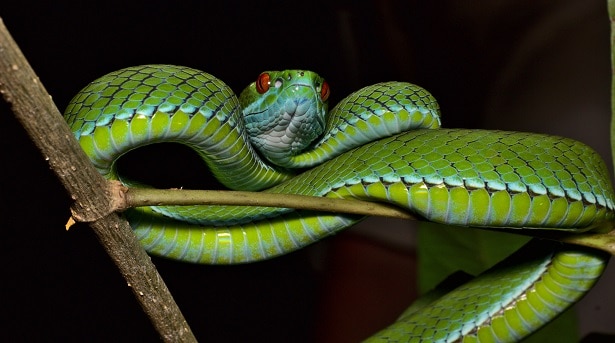
Only discovered in 2012, this species was found on the doorstep of Ho Chi Minh City, Vietnam’s capital. Trimeresurus rubeus lives in woodlands and was evidently part of the large green pitviper (Trimeresurus) family, yet differed by its ruby red eyes, which weren’t filled with blood, but their natural colour. Trimeresurus rubeus possesses the family’s usual thin white stripe on the flanks, which is slightly wider than normal.
The Trimeresurus family has 44 members, but the ruby-eyed pitviper is most closely related to the large-eyed pitviper (T. macrops), and Cardamom pitviper (T. cardamomensis). These three form a subgroup within the family. Its geographical range is small, including only eastern Cambodia and southern Vietnam.
Specifically, Trimeresurus rubeus was discovered in Cat Tien National Park, where it lives alongside its relative the white-lipped pitviper. This park hosts an estimated 45 snake species, and covers 719 square kilometres. Tourist trams drive through regularly, with strict instructions to look and not touch. Other animals include gibbons and sunbears, which the ruby-eyed pitviper probably doesn’t try to eat. Trimeresurus rubeus is arboreal, but not completely restricted to trees, while they possess a deadly venom.
| 2 | Laotian wolf snake |
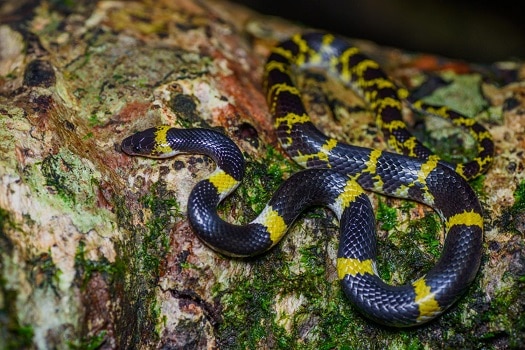
Another resident of Cat Tien National Park, and forests generally, while also paying human households a visit. Laotian wolf snakes measure 50cm and can be found on wooden porches, waiting for geckos to walk past.
This is a nocturnal snake which slithers along the ground, and swallows up lizards and frogs whenever it gets the chance. Laotian wolf snakes make easy pickings for predators as they have virtually no defence – neither a corrosive venom nor a fierce personality. Their mouth is too small to land a consequential bite in humans.
This species is similar to the common wolf snake, but has a shorter and narrower snout. Another difference is that the white bars are usually yellow, hence the alternative name “yellow-barred wolf snake”. From afar, Lycodon laoensis looks black, but is actually a deep bluish grey. At first, its barred patterns are tight and organised. As the tail approaches, the bands get more and more dishevelled and sometimes transform into circles. The amount of bands varies from 13-26. Laotian wolf snakes particularly like mountains and hilly regions.
| 3 | Indochinese ratsnake |
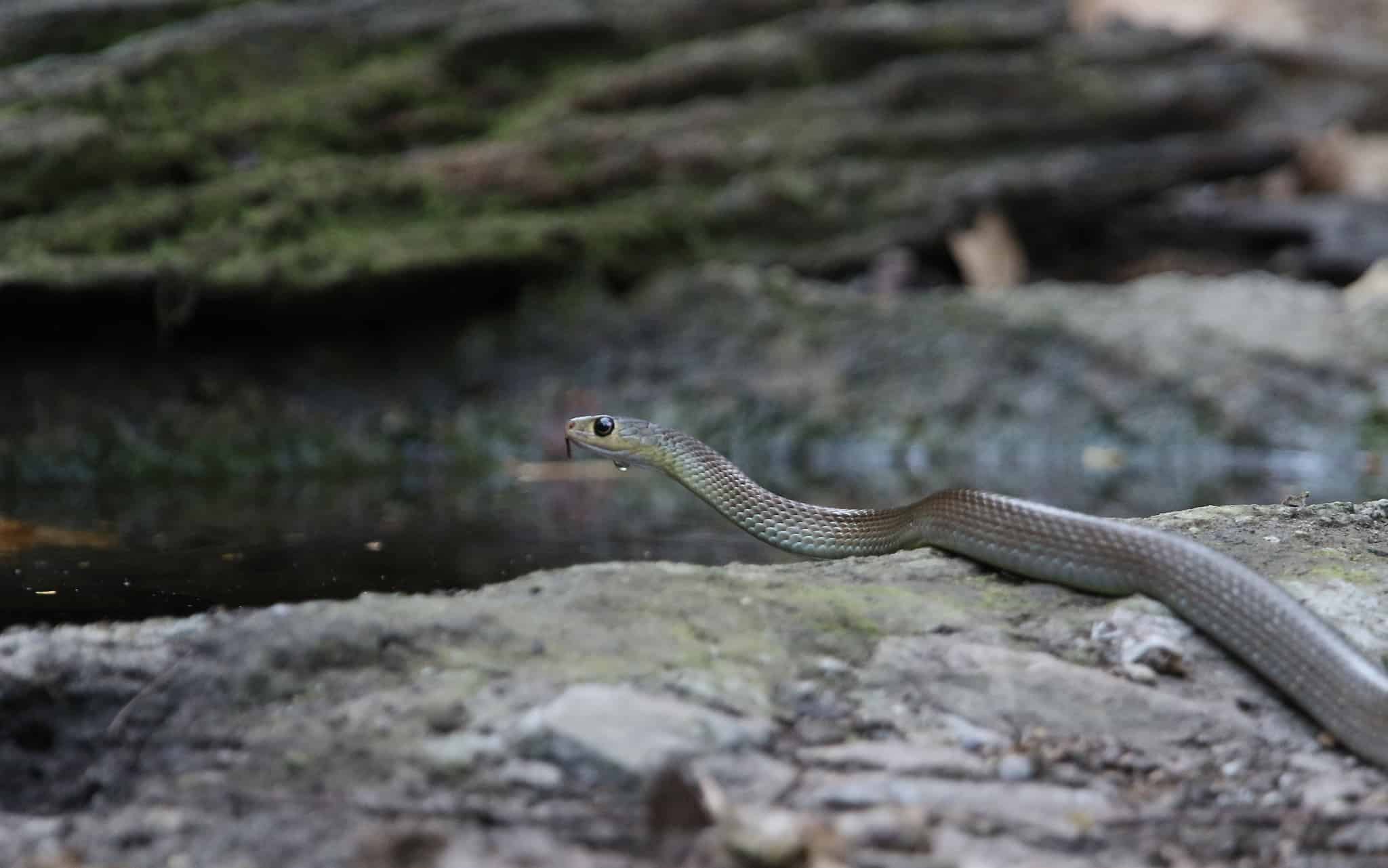
This 2 metre snake has been witnessed slithering down the streets of Ho Chi Minh City itself, specifically the urban zone of District 7. Residents may have to step over this long, non-venomous, but occasionally vicious serpent on their way to buy milk at 9am.
The Indochinese ratsnake (Ptyas korros) is abundant in the southern half of Vietnam, with no shortage of sightings. It’s the sister species of the oriental ratsnake, which also inhabits Vietnam, but has a far lower density of sightings (map, map).
Indochinese ratsnakes also appear in the wilds. They appear in many habitats, from forests to fields, though favouring ones with a water source nearby. The banks of rivers and reservoirs and rice paddy fields are common hangouts for Indochinese ratsnakes. This snake is like a garbage disposal unit – confirmed prey including golden skinks (Eutropis multifasciata), Tanezumi rats, Malayan field rats. Indochinese ratsnakes are active and energetic, yet you may also find them resting calmly on a stone. Chinese eat this species in soup, and a vast trade exists. 109 registered farms rear Ptyas korros in Vietnam, and an estimated 76,247 individuals were traded in 2014.
| 4 | Malayan pitviper |
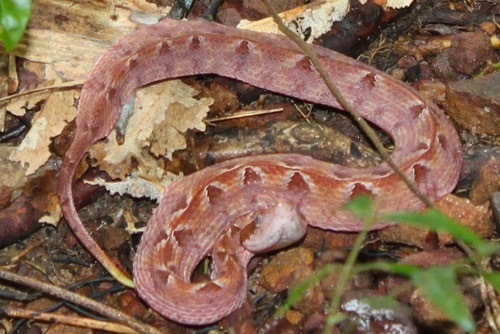
This is the species most likely to send you fleeing across the Vietnamese border with your tail between your legs, vowing never to return. Malayan pitvipers (Calloselasma rhodostoma) measure 0.5-1.2 metres and have a venom rich in proteases and haemorrhagins.
One of the best studies yet gathered snakebite data from Cho Ray Hospital, in Ho Chi Minh City (formerly known as Saigon). From April to June 2001, and from June to July 2002, there were 131 snakebites recorded in this hospital. 93.1% were venomous, and of those, Malayan pitvipers caused 30.5%. This was just ahead of the white-lipped pitviper at 28.2%, Siamese spitting cobra at 13% and monocled cobra (also at 13%). Of the 6 fatal cases, 4 were caused by Malayan pitvipers.
Swelling, haemorrhage and necrosis are the standard symptoms when bitten by this snake. Gangrene is a possibility. Malayan pitvipers favour forests most of all, but also palm oil and rubber plantations, and timber on the verges of villages. This brings them into regular contact with humanity. Malayan pitvipers are jut as comfortable in manmade fields as natural forests.
| 5 | Siamese catsnake |
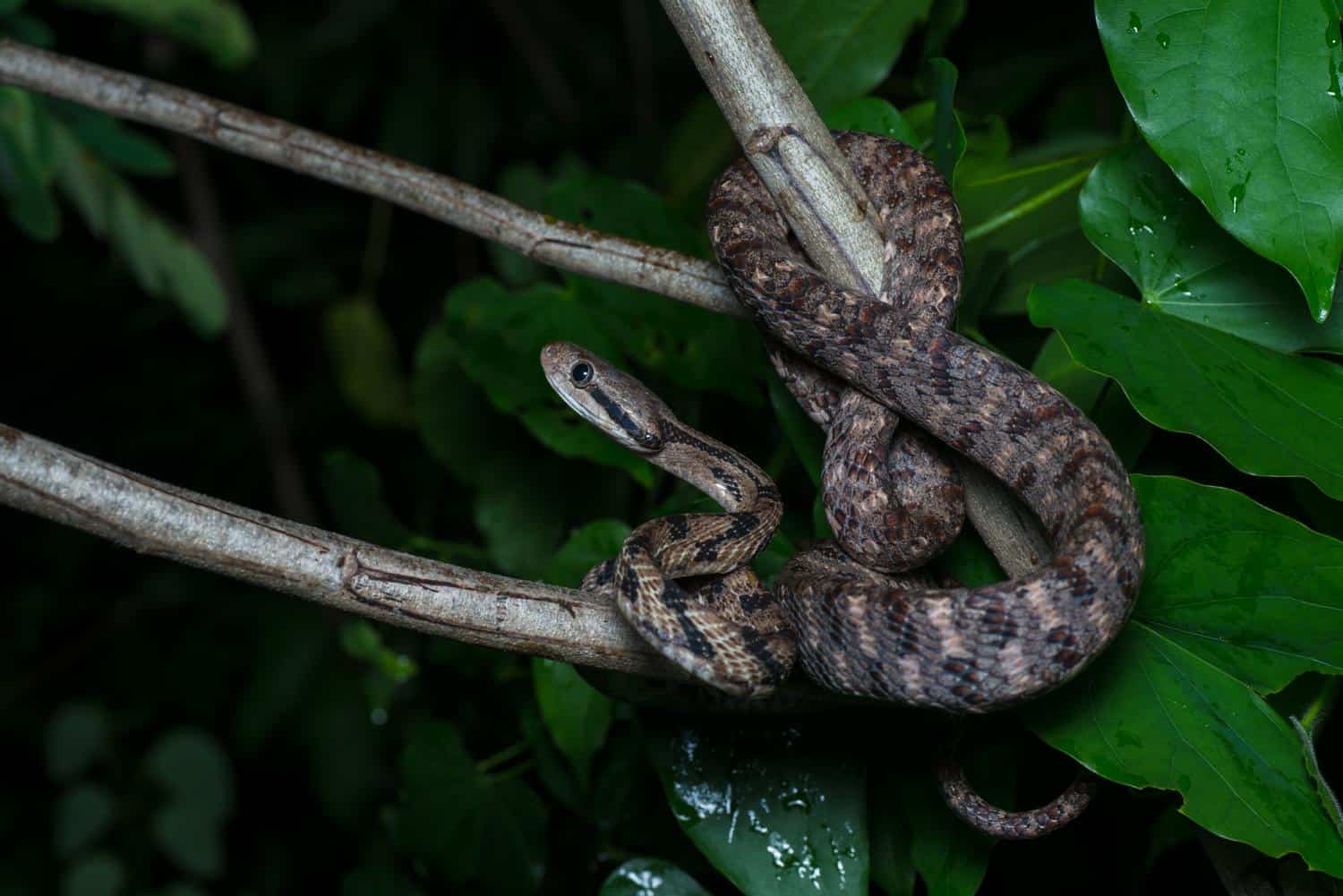
This thin snake loves to climb people’s wooden roofs, and is a tree dweller which reaches 1700 metres above sea level. Siamese catsnakes are normally extremely slender, but have a disturbing ability to inflate their neck, which looks like a meal is lodged in their throat, or like a pelican about to swallow a fish. They also open their mouths wide and strike repeatedly. Siamese catsnakes (Boiga siamensis) possess venom, but its intensity is unknown – whether it’s mild like most catsnakes or surprisingly intense like the black-headed catsnake. There’s rumours of a herpetologist called Frank Cuesta who was bitten in 2014, and supposedly suffered a swollen arm requiring treatment for a month.
The catsnake family is huge (38 members), but Boiga siamensis is easy to separate. It has a dark stripe beginning at its eye, combined with snowy white spots on its lower flanks, just adjacent to its belly. It could never be confused with the green catsnake or the black-headed catsnake, which has very simple patterns. That said, Siamese catsnakes vary in appearance, as some are mottled like above, while others have much cleaner alternating brown and beige tones.
Siamese catsnakes are secretly one of Vietnam’s largest species, reaching 1.9 metres. Ho Chi Minh City is one place they’ve been sighted.
| 6 | Bocourt’s mud snake |
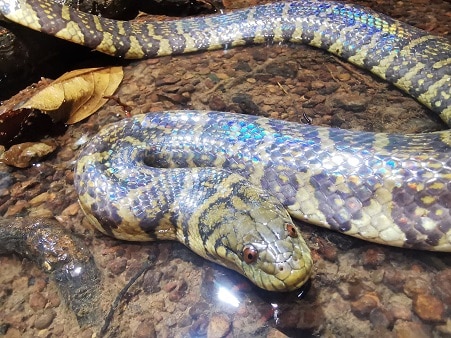
This is the opposite to most snakes on our list. Rather than having a huge family, it’s the only member of its family. Bocourt’s water snake (Subsessor bocourti) lives in Vietnam, Cambodia and Thailand and wallows in humid, stagnant water bodies. This can be marshes, shallow lakes, rice fields and ponds. They normally stay in water, but travel overland during heavy rains at night, when they have a moisture shield. Bocourt’s mud snake likes cover and normally hide near logs on the borders of ponds. This species can be watched, examined and picked up with little risk of hospitalisation. That said, bites happen occasionally, and Bocourt’s watersnake has large and brutal teeth.
Their colours seem perfectly designed to blend with their swampy habitats. At birth, this is a snake of brightly contrasting black and yellow. With age, the colours blur together and become more indistinct. Bocourt’s mud snake has a naturally fat body and black eyes which blend with their black head. Numbers of Bocourt’s mud snakes have declined in Vietnam, due to overharvesting in the wild.
| 7 | Vogel’s pitviper |
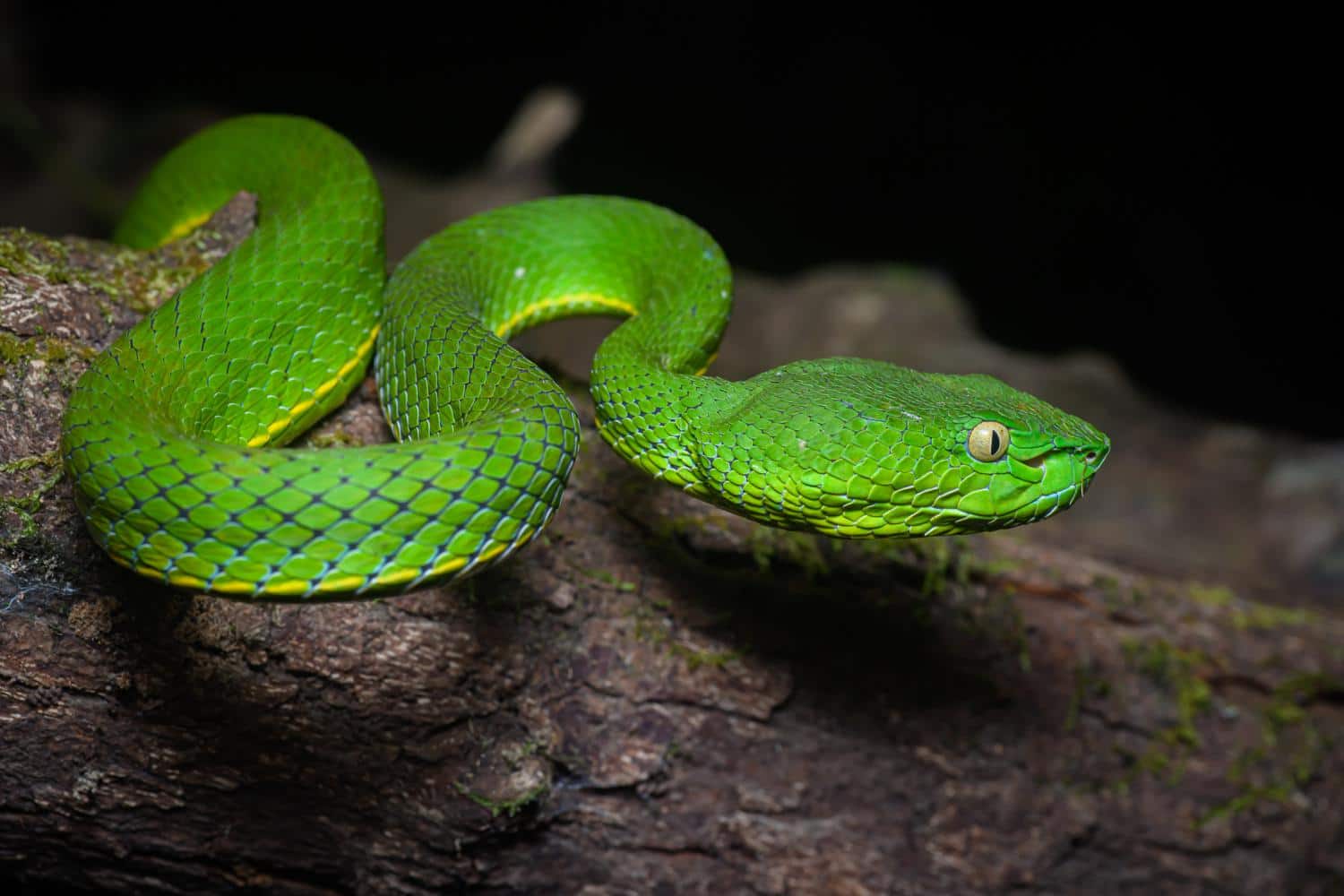
Another of Vietnam’s green pitvipers. As usual, Trimeresurus vogeli has sharply vertical pupils and an unturned mouth with a permanent hungry expression. This 80-110cm species inhabits evergreen forests, but also wide open grasslands, at altitudes of 200-1200 metres. They’ve even been found in the rafters of a restaurant.
Males of this species are different, with white spots down their vertebrae which females lack. Females tend to be a denser, grassier green, while males are paler with hints of blue. Both have a triangular head which is far wider than their neck. Compared to other green pitvipers, Trimeresurus vogeli is easiest to distinguish by the lack of red on its tail. The most you get is maybe a rusty brown tip.
Trimeresurus vogeli eat lizards, a confirmed species being the Bidoup bent-toed gecko. It swallows these geckos tail first, taking approximately 30 minutes to fully swallow. Vogel’s pitvipers climb trees with ease and prefer perches within 2 metres of ground level. You can find this venomous species in Vietnam, Cambodia, and southeastern Thailand.
| 8 | Hampton’s slug snake |
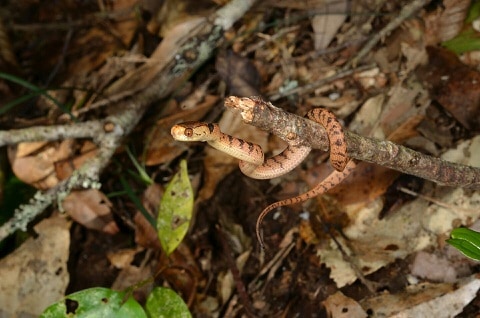
Hampton’s slug snake (Pareas hamptoni) was discovered in 1905, but is very rare in museum collections around the world. This snake gets its name from its slimy diet. They possess a brown body overlaid with black bars, and average at 75cm. Their scales are slightly keeled (sharp) to touch, despite being hard to tell from a camera shot (unlike the hairy bush viper). Hampton’s slug snake prefers moist places, including monsoonal evergreen forests and peat swamp forests. Streams within forests are the top place to find this species in Vietnam.
Hampton’s slug snake also exists in Thailand, but only the extreme southeast (Chanthaburi province). Instead, their range begins north of Ho Chi Minh City, continues through Laos, and ends in southern China. This species is rare wherever it lives and never swells to vast numbers.
Like the Berdmore’s slug snake in Thailand, its head is far wider than its neck. Their tongue is a fleshy pale pink, and their eyes are barely a different colour to their body.
| 9 | Deuve’s kukri snake |
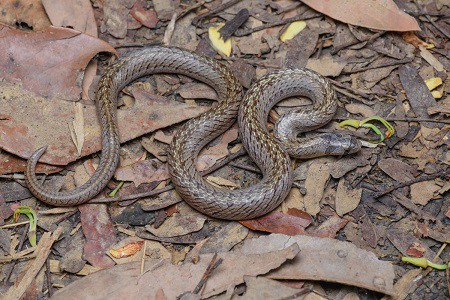
Oligodon deuvei is closely related to the striped kukri snake (Oligodon taeniatus), a widespread citizen of central Thailand. Its colours as similarly dull, but Deuve’s kukri snake has a bright stripe down its spine with thinner (or non-existent) black markings on each border. They also lack tail blotches, and a dark stripe on the lower flanks.
Deuve’s kukri snake appears in forests, bamboo thickets near rice paddies, but also backgardens. They’re not averse to human settlements at all. Deuve’s kukri snakes are nocturnal and stick to the ground. Otherwise, little is known of this species. In 2016, they were discovered in Thailand for the first time.
Deuvei refers to Jean Deuve, born in 1918, who was wounded in World War 2 and parachuted into Laos in 1945 to train the local anti-Japanese guerrillas. This little parachute excursion ultimately lasted 19 years, in which Deuve became chief of intelligence and an advisor to the prime minister. He also became a renowned expert on the local snakes, eventually writing a 1970 book called Serpentes du Laos.
Like the ruby-eyed pitviper, Deuve’s kukri snake is found in Cat Tien National Park near Ho Chi Minh City. The park also host the extremely rare Cat Tien kukri snake, which has oranges patches down its spine.
| 10 | Nganson bronzeback |
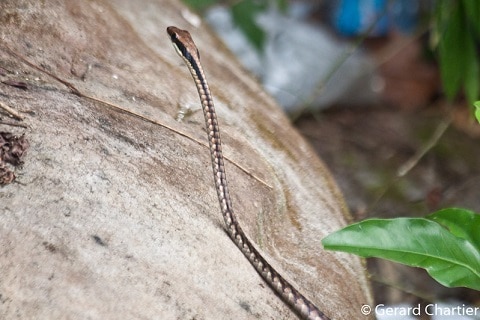
A harmless snake to humans, with large eyes and a red tongue with a black tip. Nganson bronzebacks (Dendrelaphis ngansonensis) stretch to 150cm and are grapplers which acquire prey through sheer determination.
This Vietnamese snake grabs its prey as they sit on branches, and can maintain its hold even if the pair lose their balance and plummet to the hard ground. Frogs are their main prey, including the black-webbed treefrog, and in humid Vietnam, there’s plenty to choose from.
Dendrelaphis ngansonensis was originally a subspecies of the painted bronzeback, but granted full species rights in 1999. The two look very different. Nganson bronzebacks are far browner and there’s no cleanly separated cream-coloured belly. A black stripe beginning behind the eye is another ID sign. The Nganson’s bronzeback is relatively thick for its family, but that’s not saying much; they still have a whiplike tail which looks like it might snap. Living in forests and spending much of time in branches, US soldiers almost certainly met this species without knowing its identify. Nganson bronzebacks range from southern China through to northern and central Vietnam.
